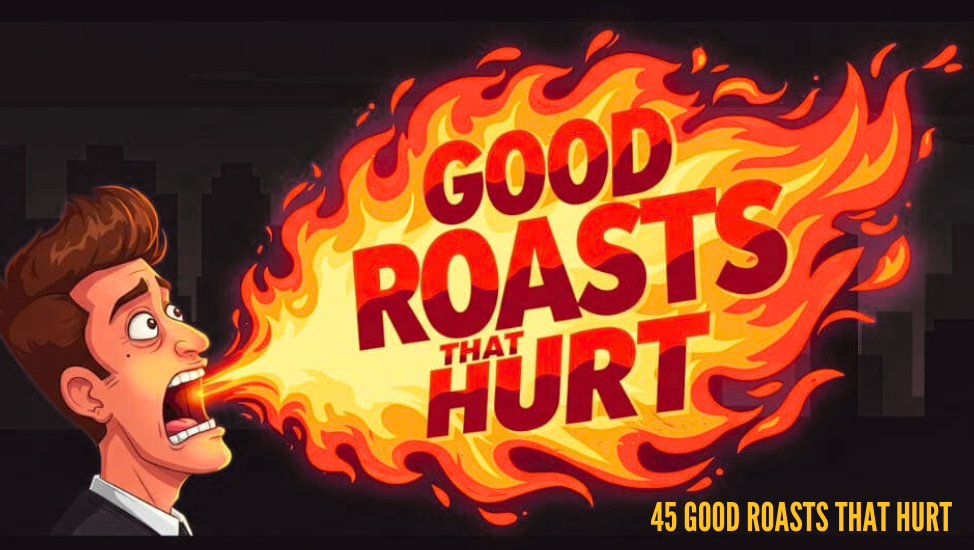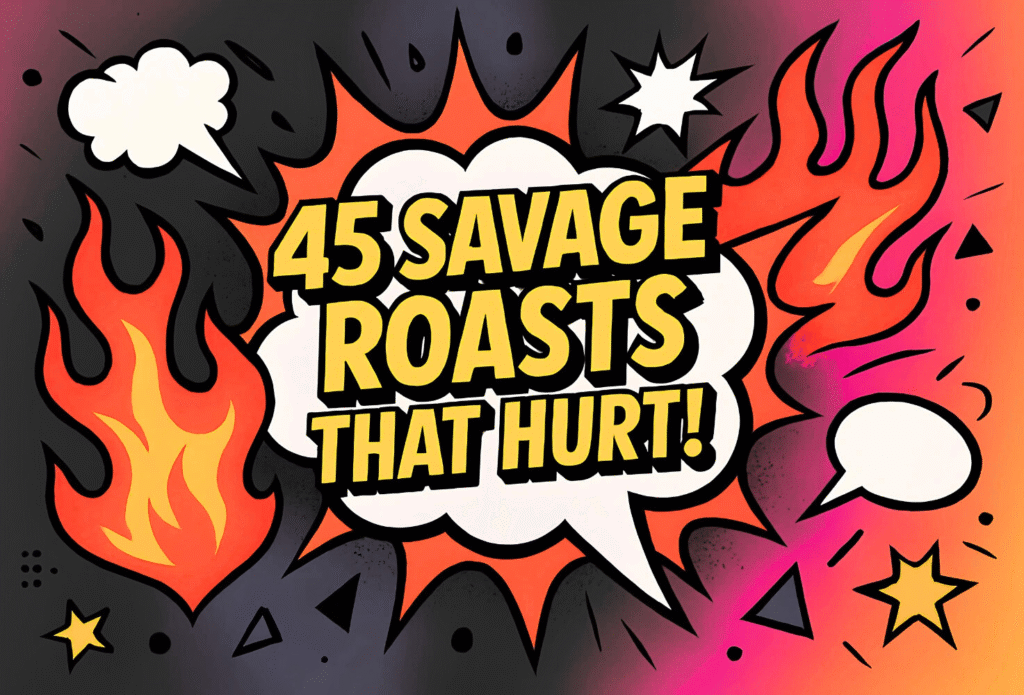Introduction to Roasting
Roasting is one of the oldest forms of comedy where humor comes wrapped in stinging words. When people search for “45 good roasts that hurt,” what they are really looking for is a collection of witty, cutting remarks that can spark laughter while also carrying a slight sting of truth. Roasts are not just insults; they are carefully crafted lines that mix observation, exaggeration, and rhythm to create humor that feels bold and memorable. Whether used among friends in playful banter or delivered by professional comedians on stage, 45 good roasts that hurt are a unique art form that thrives on timing, creativity, and audience connection.
The Origins of 45 good roasts that hurt Culture
The practice of roasting has deep cultural roots. One of the most famous institutions of roast comedy is the Friars Club in New York City, which began hosting roasts in the mid-twentieth century. These gatherings were private events where well-known figures would be celebrated by enduring an evening of humorous insults from their peers. Over time, this practice gained mainstream attention and evolved into televised specials such as the Dean Martin Celebrity Roasts and, more recently, the Comedy Central 45 good roasts that hurt. Roasting transformed from a niche performance into a celebrated comedic tradition, offering both audiences and participants a chance to laugh at the quirks and flaws that make people human.
Why Roasts Hurt in the Right Way
A 45 good roasts that hurt because it often strikes close to home, but that is exactly why it works. Psychological studies have shown that social pain, such as embarrassment or insult, activates the same brain regions as physical pain. Yet in a roast setting, the sting is softened by humor and the shared understanding that the remarks are not meant to cause lasting harm. Instead, the pain is temporary, and the laughter it creates helps turn discomfort into entertainment. People enjoy roasts because they combine truth and exaggeration in a way that feels daring but also strangely affectionate. Being roasted can even be seen as a compliment because it means you are important enough to be noticed and teased in public.
The Rules of a Good Roast
Behind every successful 45 good roasts that hurt lies an unspoken code of conduct. A good roast is sharp but not cruel, funny but not humiliating. The best comedians know how to balance truth and exaggeration without crossing lines that would cause genuine harm. Timing is another crucial element; even the sharpest line can fall flat if delivered without rhythm or surprise. Roasts also depend on context. A joke that is hilarious among close friends might feel inappropriate in a workplace or family gathering. That is why understanding your audience is as important as crafting the insult itself.
Table: Overview of 45 Good Roasts That Hurt
| Category | Example Style | Why It Hurts (Yet Funny) | Best Used With |
|---|---|---|---|
| Intelligence Roasts | “You bring everyone joy… when you leave.” | It questions quick thinking in a witty way. | Friends who know your humor |
| Appearance Roasts | “You have a face for radio.” | Exaggerates looks with playful imagery. | Light banter, not serious |
| Personality Roasts | “You’re the human version of a typo.” | Compares flaws with something relatable. | Roast battles, close friends |
| Effort Roasts | “You put the ‘pro’ in procrastination.” | Targets habits with funny wordplay. | Casual fun in groups |
| Behavior Roasts | “You’re as useful as a screen door on a submarine.” | Attacks actions with creative comparison. | Comedy settings, playful insults |

The Appeal of “45 Good Roasts That Hurt”
Articles and lists titled “45 good roasts that hurt” have become extremely popular online. They serve as ready-made collections of one-liners for people who want to entertain their friends, spice up conversations, or prepare for roast battles. The appeal lies in their variety. These 45 good roasts that hurt often play on intelligence, physical quirks, personal habits, or social awkwardness. They use metaphors, similes, and clever wordplay to make insults sound more poetic than harsh. For example, calling someone “the human version of a typo” is far more creative than simply calling them clumsy. Such lines hurt just enough to draw a reaction but are still funny enough to earn a laugh.
Famous Roasts in Popular Culture
Modern audiences are most familiar with roasting through televised specials like the Comedy Central Roasts. Celebrities such as Justin Bieber, Charlie Sheen, and James Franco have all been willing targets, sitting through hours of sharp remarks delivered by comedians and fellow stars. These events reveal how roasts function as cultural rituals, where status and reputation are acknowledged by subjecting oneself to public teasing. At the end of every roast, the guest of honor usually responds, proving they can take a joke and laugh along. This ritual shows the dual nature of roasting: it can hurt, but it also celebrates resilience, humility, and humor.
The Psychology of Giving and Taking a Roast
Roasting requires a unique blend of confidence and empathy. To deliver a roast, a person must be creative and observant, able to turn ordinary flaws into memorable punchlines. To receive a roast, one must have thick skin and self-awareness. People who can laugh at themselves often come across as more likeable and confident, which is why public figures agree to participate in roast events. On the other hand, failing to handle a roast gracefully can make someone appear insecure or defensive. The psychology behind roasting shows that it is not just about the words spoken, but also about the reactions they provoke and the social bonds they strengthen.
Crafting Roasts That Work
The difference between a mean insult and a clever roast often comes down to creativity. A roast that hurts in the best way does not rely on cruelty but on smart phrasing and originality. Instead of directly calling someone boring, a roast might compare them to a screen door on a submarine. This creative exaggeration makes the insult funny, vivid, and memorable. Timing is also important. A 45 good roasts that hurt delivered with a pause or a well-placed smile carries more weight than one blurted out carelessly. For those who want to use 45 good roasts that hurt in everyday life, remembering these techniques helps ensure that the humor lands without causing lasting offense.
The Risks of Roasting
Roasting may be entertaining, but it also carries risks. A poorly delivered roast can cross into bullying, especially if the target has not agreed to be roasted or if sensitive personal issues are used as material. On social media, roasts can spread quickly and take on a harsher tone without the context of humor or friendship. This is why ethical roasting is essential. Good roasters avoid topics like race, religion, gender, or trauma, focusing instead on harmless quirks, personality traits, or funny habits. Responsible roasting ensures that the laughter is shared by everyone, not enjoyed at the expense of someone’s dignity.
Conclusion
The search for “45 good roasts that hurt” reflects a broader fascination with comedy that pushes boundaries while still keeping people laughing. Roasting is more than just delivering insults; it is an art form built on creativity, timing, and social understanding. It has a long history rooted in comedy clubs and has grown into a cultural phenomenon with mass appeal. While it can sting, the best roast balances humor with respect, turning temporary discomfort into lasting entertainment. In many ways, roasting represents the human ability to laugh at flaws, to find truth in humor, and to build stronger social bonds through the sharp edge of wit.
Q: What are 45 good roasts that hurt?
A: They are clever, funny one-liners designed to sting a little but make people laugh.
Q: Are roasts supposed to be mean?
A: No, a good roast is witty and playful, not cruel or harmful.
Q: Can I use roasts with friends?
A: Yes, as long as everyone understands it’s a joke and no one feels offended.
Q: Where can I find funny roasts?
A: You can find them in comedy shows, online lists, and roast battle events.
Q: How do I make a roast hurt but still funny?
A: Focus on humor and exaggeration, not personal or sensitive issues.
